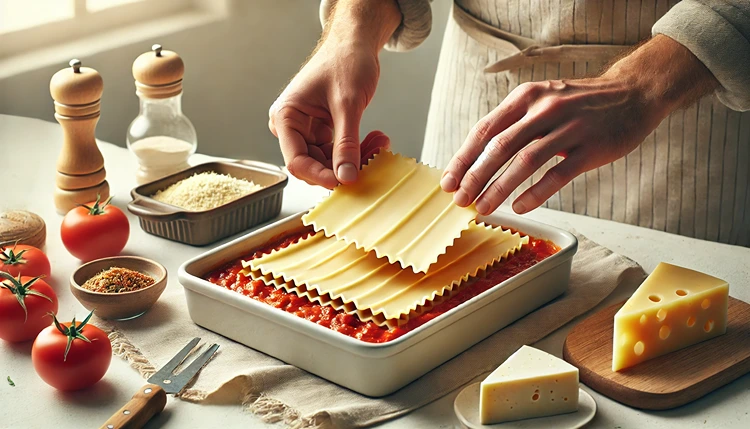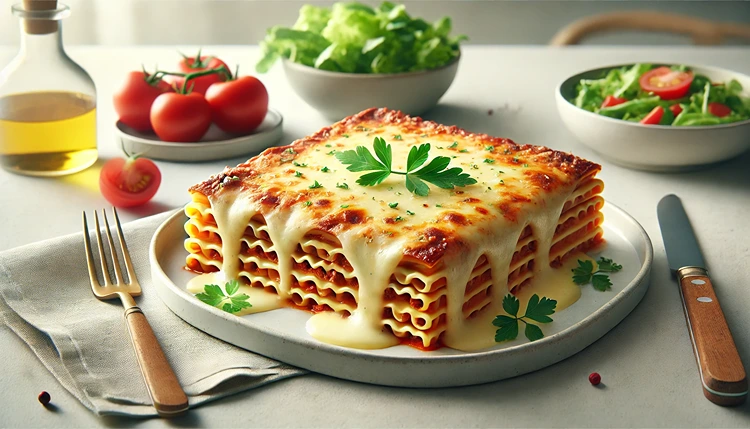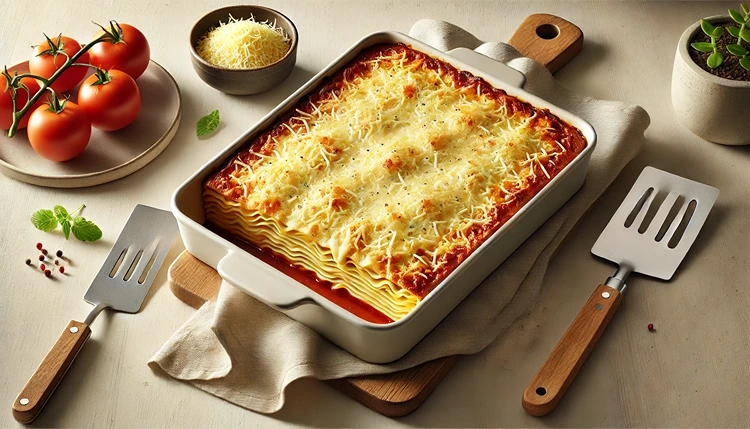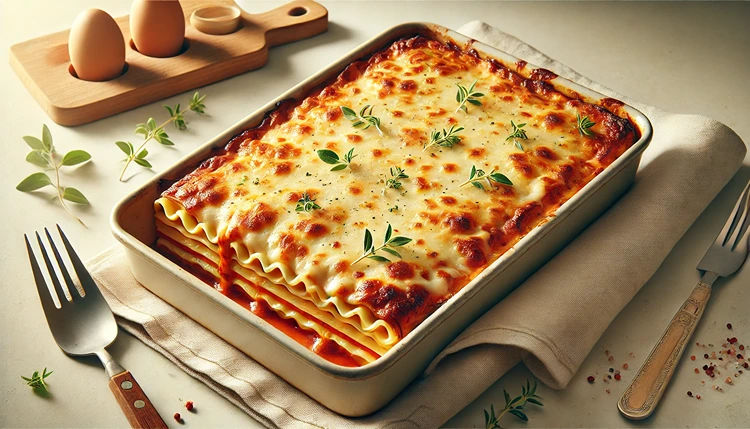Lasagna is one of those classic comfort foods that never fails to bring a little warmth and joy. But for those of us living gluten-free or avoiding dairy, this dish can feel a bit out of reach. Not anymore! In this recipe, we’re going to explore how to make the best gluten-free lasagna with a creamy, delicious dairy-free cheese that everyone will love—yes, even those who aren’t on a gluten-free diet. Whether you’re cooking for a special occasion or just looking for a satisfying dinner option, this recipe is sure to hit the spot.
Why Choose Gluten-Free and Dairy-Free Lasagna?
Whether you’re celiac, gluten-sensitive, lactose intolerant, or simply choosing to eliminate gluten and dairy from your diet, finding meals that fit your dietary needs while still tasting delicious can be a challenge. Traditional lasagna is loaded with gluten-filled pasta and rich dairy cheeses, making it off-limits for many. But with a few tweaks, you can still enjoy this Italian favorite.
By using gluten-free lasagna noodles and dairy-free cheese alternatives, this recipe offers all the satisfaction without compromising flavor or texture. It’s perfect for those looking to reduce inflammation, improve digestion, or just experiment with healthier alternatives to traditional recipes.
What Makes This Gluten-Free Lasagna Stand Out?
The key to an amazing gluten-free lasagna is in the quality of the ingredients. From the gluten-free noodles to the dairy-free cheese, everything should taste as close to the real deal as possible. And guess what? It’s totally possible to achieve this. Here’s what you can expect from this recipe:
- Rich, flavorful tomato sauce with a hint of garlic and herbs.
- Layers of perfectly cooked gluten-free lasagna noodles that hold together just like traditional pasta.
- A creamy, melty dairy-free cheese that makes you forget you’re not eating real cheese.
- A dish that reheats beautifully, making it great for leftovers or meal prep.
What Gluten-Free Lasagna Noodles Should You Use?

When it comes to gluten-free lasagna noodles, not all brands are created equal. You want to find noodles that maintain their structure and texture during baking without turning mushy. Here are a few options:
Best Brands of Gluten-Free Lasagna Noodles
There are several high-quality brands of gluten-free lasagna noodles that perform well in this recipe:
- Barilla Gluten-Free Lasagna: Known for its close resemblance to traditional pasta in both taste and texture, Barilla’s gluten-free lasagna noodles cook up firm and don’t fall apart during baking.
- Tinkyada Brown Rice Lasagna Noodles: Made from brown rice, these noodles are a bit heartier and have a slightly different flavor but hold up well and offer a wholesome, slightly nutty taste.
- Jovial Gluten-Free Lasagna Noodles: These noodles are made from organic brown rice and are a favorite for their delicate texture and consistency.
Helpful Hint:
If you’re in a hurry, look for “oven-ready” gluten-free lasagna noodles that don’t require pre-boiling. Just layer them straight into the dish with your sauce and cheese, and they’ll cook perfectly in the oven.
Which Dairy-Free Cheese is Best for Lasagna?
The trickiest part of making a dairy-free lasagna is finding a cheese substitute that melts well and has a rich, cheesy flavor. Luckily, there are some fantastic dairy-free cheese options available now that work beautifully in baked dishes like lasagna.
Top Dairy-Free Cheese Options for Lasagna
Here are some of the best dairy-free cheeses to use in this recipe:
- Violife Just Like Mozzarella: This dairy-free cheese melts beautifully and has a mild flavor similar to traditional mozzarella. It’s perfect for layering in lasagna.
- Miyoko’s Creamery Mozzarella: Made from cultured cashew milk, this cheese has a rich flavor and creamy texture, ideal for those looking for a more natural alternative.
- Daiya Mozzarella Shreds: This is a popular choice for its convenience and ease of melting. It has a slightly stretchy texture, much like dairy cheese.
For a ricotta substitute, you can either find pre-made vegan ricotta or make your own using tofu, cashews, or almonds. The key is getting that creamy, slightly tangy texture that complements the richness of the tomato sauce.
Gluten-Free Lasagna Ingredient Alternatives
| Ingredient | Substitute | Best for |
|---|---|---|
| Gluten-Free Lasagna Noodles | Gluten-Free Tortillas | Mexican-style Lasagna |
| Dairy-Free Mozzarella | Cashew Cheese | Rich, creamy texture |
| Ricotta Cheese | Tofu Ricotta | Vegan or dairy-free versions |
| Marinara Sauce | Pesto or White Sauce | Non-tomato-based Lasagna |
Preparing the Perfect Tomato Sauce
A great lasagna starts with a flavorful sauce. You want something that’s rich, hearty, and has just the right balance of herbs and spices. Whether you make your sauce from scratch or use a quality store-bought version, it’s important to simmer the sauce long enough to bring out all the flavors.
Key Ingredients for a Delicious Tomato Sauce
Here’s what you’ll need to create the perfect lasagna sauce:
- Crushed Tomatoes: Use a can of high-quality crushed tomatoes as the base of your sauce. Look for brands that don’t add sugar or preservatives.
- Garlic and Onion: These two ingredients provide the foundation for most Italian sauces, adding depth and flavor.
- Herbs: Dried oregano, basil, and thyme are classic lasagna herbs, but feel free to experiment with fresh herbs if you have them on hand.
- Olive Oil: A good olive oil adds richness and helps meld all the flavors together.
For a deeper flavor, let the sauce simmer for at least 30 minutes. If you want to add a little more complexity, try throwing in a splash of red wine or a pinch of red pepper flakes for a subtle kick.
Helpful Hint:
If you’re short on time, using a store-bought marinara sauce is a great alternative. Just make sure to check the label to ensure it’s gluten-free and doesn’t contain any sneaky dairy ingredients.
Building Your Gluten-Free Lasagna

Once you have your noodles, cheese, and sauce ready, it’s time to assemble your lasagna. The layering process is straightforward, but here are some tips to ensure everything turns out perfectly.
How to Layer Your Lasagna
- Start with Sauce: Always begin with a layer of sauce on the bottom of your baking dish. This prevents the noodles from sticking and ensures every bite is packed with flavor.
- Next, Noodles: Place a single layer of gluten-free lasagna noodles over the sauce. Make sure the noodles aren’t overlapping too much.
- Add Cheese: Spread a layer of your dairy-free cheese over the noodles, whether it’s mozzarella-style shreds or a homemade vegan ricotta.
- Repeat: Continue layering sauce, noodles, and cheese until your dish is full, usually three to four layers depending on your pan size.
- Top with Extra Cheese: Finish with a generous layer of dairy-free cheese on top to get that classic golden, bubbly lasagna topping.
After assembling your lasagna, cover it with foil and bake it at 375°F (190°C) for about 45 minutes. Then remove the foil and bake for another 10 to 15 minutes to let the top brown slightly.
How Long Should You Let Lasagna Rest Before Serving?
After spending time perfecting your gluten-free lasagna, it might be tempting to dig in right away—but don’t! Allowing your lasagna to rest for about 10-15 minutes after removing it from the oven helps the layers set and makes it easier to slice. This brief cooling period also allows the flavors to meld together, giving you that perfect bite.
Helpful Hint:
Resist the urge to slice into your lasagna right out of the oven. If you serve it too soon, it may fall apart. Letting it rest not only helps with presentation but also enhances the overall flavor.
What Can You Serve with Gluten-Free Lasagna?
Lasagna is a hearty dish on its own, but adding a few side dishes can elevate the entire meal. Here are some great gluten-free options that complement your lasagna perfectly:
Gluten-Free Garlic Bread
A classic pairing with lasagna is garlic bread. To make a gluten-free version, use a gluten-free baguette or bread, slice it, and slather it with garlic butter before toasting it in the oven. You can sprinkle a bit of dairy-free cheese on top if you want an extra cheesy bite.
Fresh Salad
Lasagna can be a rich and filling dish, so a light, fresh salad can help balance things out. A simple mixed greens salad with a tangy vinaigrette can cut through the richness of the lasagna, making each bite even more enjoyable.
Steamed Vegetables
If you’re looking for something warm to serve alongside your lasagna, steamed vegetables like broccoli, green beans, or zucchini work beautifully. Toss them in a little olive oil and sprinkle with salt and pepper for a simple yet tasty side dish.
Common Mistakes to Avoid When Making Gluten-Free Lasagna
Even the best cooks can run into trouble with lasagna. Here are some common mistakes to watch out for when making your gluten-free version:
1. Not Pre-Cooking the Noodles (If Required)
Some gluten-free lasagna noodles require pre-cooking, while others are oven-ready. Always check the package instructions to see if your noodles need to be boiled first. If you skip this step, your noodles might end up too firm or even crunchy after baking.
2. Using Too Much Sauce
It might be tempting to load up on sauce, but too much can make your lasagna soggy. Aim for an even balance between noodles, sauce, and cheese in each layer.
3. Not Enough Cheese
In lasagna, cheese acts as a binder, holding everything together. If you’re skimpy with the cheese, your lasagna may fall apart when you slice it. Don’t be afraid to layer on a good amount of dairy-free cheese for the best results.
Can You Freeze Gluten-Free Lasagna?
Absolutely! Gluten-free lasagna freezes beautifully, making it a great option for meal prep. Whether you want to store leftovers or prepare a whole lasagna in advance, here’s how to do it:
How to Freeze Lasagna
- Assemble the Lasagna: Prepare your lasagna as you normally would, but don’t bake it yet. You want to freeze it before cooking.
- Wrap It Tightly: Cover the unbaked lasagna tightly with plastic wrap, then a layer of foil to prevent freezer burn.
- Label and Freeze: Don’t forget to label your lasagna with the date before placing it in the freezer. Lasagna can be stored for up to three months.
How to Reheat Frozen Lasagna
When you’re ready to enjoy your frozen lasagna, here’s how to reheat it:
- Thaw in the Fridge: Move the lasagna to the fridge the night before you plan to bake it so it has time to thaw.
- Bake as Usual: Once thawed, bake it at 375°F (190°C) for about 45 minutes to an hour, or until heated through.
Gluten-Free Lasagna with Dairy-Free Cheese
Prep Time: 25 mins | Cook Time: 60 mins | Total Time: 85 mins

Ingredients
- 1 box gluten-free lasagna noodles
- 2 cups dairy-free mozzarella cheese
- 1 jar marinara sauce (check for gluten-free)
- 1/2 onion, chopped
- 2 cloves garlic, minced
- 1 tablespoon olive oil
- 1 teaspoon dried basil
- 1 teaspoon dried oregano
- Salt and pepper to taste
Instructions
- Preheat your oven to 375°F (190°C).
- Heat olive oil in a pan over medium heat. Add chopped onion and garlic, sauté until soft.
- Add marinara sauce, basil, oregano, salt, and pepper. Let simmer for 15-20 minutes.
- In a large baking dish, spread a layer of sauce, then a layer of gluten-free noodles, followed by dairy-free cheese.
- Repeat layers until all ingredients are used, finishing with a layer of cheese on top.
- Cover with foil and bake for 45 minutes, then uncover and bake for an additional 10-15 minutes until golden and bubbly.
- Let the lasagna rest for 10 minutes before slicing and serving.
What’s the Secret to a Creamy Dairy-Free Ricotta?
Ricotta is an essential component of traditional lasagna, but if you’re avoiding dairy, it can be tricky to replicate. Thankfully, there are several easy ways to make a dairy-free ricotta that’s just as creamy and delicious as the real thing.
Tofu-Based Ricotta
Tofu is one of the best ingredients for making dairy-free ricotta because of its neutral flavor and smooth texture. Here’s how to make a quick tofu-based ricotta:
- Firm Tofu: Drain and press the tofu to remove excess moisture. Then, crumble it into a bowl.
- Lemon Juice: Adds a tangy flavor that mimics the slight acidity of ricotta.
- Nutritional Yeast: Provides a cheesy flavor to the ricotta, making it even more satisfying.
- Garlic Powder and Salt: Enhance the flavor, giving it depth and richness.
How to Make Tofu Ricotta
- In a bowl, crumble one block of firm tofu.
- Add 1 tablespoon lemon juice, 2 tablespoons nutritional yeast, 1 teaspoon garlic powder, and a pinch of salt.
- Mix well until the tofu is broken down and has a ricotta-like texture.
- Use it as you would regular ricotta in your lasagna.
Helpful Hint:
If you’re looking for an even creamier texture, blend the tofu ricotta in a food processor until smooth. This will give you a consistency closer to traditional ricotta, perfect for lasagna or any other baked dish.
Can You Make This Lasagna Ahead of Time?
Yes, one of the best things about lasagna is that it can easily be made ahead of time. Whether you’re prepping for a busy weeknight or getting ready for a dinner party, making this gluten-free lasagna ahead of time will save you stress later on. Plus, letting the lasagna sit for a while before baking allows the flavors to meld even more.
How to Make Lasagna Ahead of Time
Here’s a simple method for prepping your lasagna in advance:
- Assemble the Lasagna: Follow all the steps in the recipe up to the point of baking. Layer your sauce, noodles, and dairy-free cheese as usual.
- Cover and Refrigerate: Once assembled, cover the lasagna tightly with plastic wrap or foil and place it in the fridge. You can store it this way for up to 24 hours before baking.
- Bake When Ready: When you’re ready to serve, take the lasagna out of the fridge and bake it according to the original recipe instructions. You may need to add an extra 10-15 minutes to the baking time since it’ll be cold from the fridge.
Helpful Hint:
If you’re planning on freezing your lasagna, assemble it as usual and store it in the freezer instead of the fridge. Just be sure to thaw it in the fridge overnight before baking to avoid uneven cooking.
How to Reheat Gluten-Free Lasagna
Lasagna is one of those dishes that tastes even better the next day, making leftovers a real treat. But reheating gluten-free lasagna can sometimes be tricky since gluten-free noodles have a tendency to dry out. Here’s how to reheat your lasagna so it stays moist and delicious:
Reheating Lasagna in the Oven
- Preheat Oven: Set your oven to 350°F (175°C).
- Add Moisture: To prevent the noodles from drying out, cover the lasagna with foil and add a little extra sauce or a splash of water before reheating.
- Bake: Bake the lasagna for 20-30 minutes, or until it’s heated through.
Reheating Lasagna in the Microwave
While reheating in the oven is preferred for best results, the microwave is a faster option if you’re short on time. To reheat in the microwave:
- Cover: Place your slice of lasagna on a microwave-safe plate and cover it with a damp paper towel to keep it moist.
- Heat: Microwave on medium power in 1-2 minute intervals until heated through. Be careful not to overcook it, as the noodles can become rubbery.
Making Gluten-Free Lasagna for a Crowd
If you’re hosting a dinner party or feeding a large group, this gluten-free lasagna recipe is a great option. It’s hearty, satisfying, and appeals to just about everyone—whether they’re gluten-free or not.
How to Scale the Recipe
To make enough lasagna for a crowd, simply double or even triple the ingredients. Use a larger baking dish (or multiple smaller ones) and increase the layers to ensure everyone gets a generous slice. You can also make multiple lasagnas and bake them side by side if your oven allows.
Serving Tips for a Large Group
- Offer a variety of sides, like gluten-free garlic bread and salads, so guests can customize their plates.
- Consider adding extra dairy-free cheese on top for an extra indulgent, golden crust.
- Have extra sauce on hand for anyone who prefers a saucier lasagna.
Variations on Gluten-Free Lasagna
While the classic lasagna is delicious, sometimes it’s fun to mix things up. Here are a few variations you can try to give your lasagna a unique twist:
Vegetable Lasagna
Replace the meat sauce with layers of sautéed vegetables like zucchini, spinach, mushrooms, and bell peppers. You can also add in dairy-free pesto for extra flavor. This option is perfect for those looking to add more veggies to their diet or reduce their meat consumption.
Mexican Lasagna
If you love Mexican flavors, this twist is for you. Swap out the marinara sauce for salsa, use black beans instead of meat, and add in layers of gluten-free tortillas instead of noodles. Top it off with dairy-free cheddar cheese and a dollop of guacamole for a fun and flavorful dish.
White Lasagna
If you’re in the mood for something a little different, try making a white lasagna using a dairy-free béchamel sauce. This version is creamy and rich, with layers of dairy-free ricotta, spinach, and gluten-free noodles. It’s a fantastic alternative to traditional lasagna, especially for those who love creamy dishes.
Tips for Storing Leftover Lasagna
Lasagna is one of those meals that keeps well and tastes even better the next day. Here’s how to store your leftover gluten-free lasagna:
In the Fridge
- Cool Completely: Allow your lasagna to cool completely before storing it to avoid condensation and sogginess.
- Store in an Airtight Container: Transfer the lasagna to an airtight container or cover the baking dish tightly with foil or plastic wrap.
- Keep for 3-4 Days: Leftover lasagna will stay fresh in the fridge for up to 4 days.
In the Freezer
If you have a lot of leftovers or want to freeze individual portions for later, here’s how to do it:
- Cut into Portions: Slice the lasagna into individual servings for easy reheating.
- Wrap Well: Wrap each piece tightly in plastic wrap, followed by a layer of foil to prevent freezer burn.
- Label and Freeze: Freeze the portions for up to 3 months. Be sure to label them with the date.
Weighing the Pros and Cons
Pros
- Gluten-free noodles make this dish suitable for those with gluten sensitivities or celiac disease.
- Dairy-free cheese provides a creamy texture without the discomfort for lactose intolerant individuals.
- The recipe is versatile and can be modified with various fillings like vegetables or meat alternatives.
- Lasagna can be made ahead and stored, making it perfect for meal prepping.
- It’s a healthier alternative, reducing processed ingredients while still delivering rich flavors.
- Freezes well, allowing you to enjoy leftovers for weeks without compromising taste.
Cons
- Gluten-free lasagna noodles can be more expensive than traditional pasta.
- Not all dairy-free cheeses melt or taste exactly like traditional cheese.
- The preparation time can be longer due to the multiple steps involved (sauce, layers, baking).
- Some gluten-free noodles may require extra care to avoid becoming too firm or too soft during cooking.
- Depending on the brand, some dairy-free cheeses may not achieve the same stretchiness as real cheese.
- Leftovers need proper storage to prevent the noodles from drying out in the fridge.
Frequently Asked Questions
Wrapping Up
This gluten-free lasagna with dairy-free cheese offers a delicious solution for anyone looking to enjoy a comforting classic without gluten or dairy. With gluten-free noodles, rich dairy-free cheese alternatives, and a flavorful sauce, this recipe checks all the boxes for a meal that is both satisfying and allergy-friendly. Whether you’re making it for yourself, your family, or a large gathering, the lasagna holds up well, stores perfectly, and can even be made ahead for convenience. The best part? It’s versatile enough for different fillings and can be frozen for easy meals later. Enjoy the process of creating a lasagna that everyone, regardless of dietary preferences, can enjoy!

